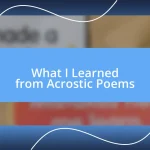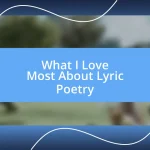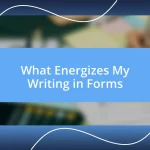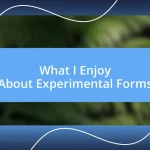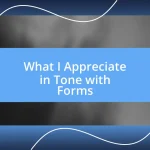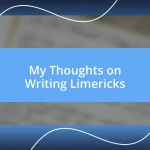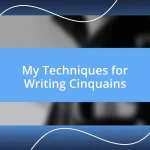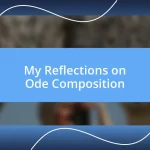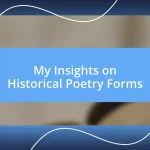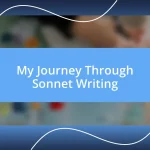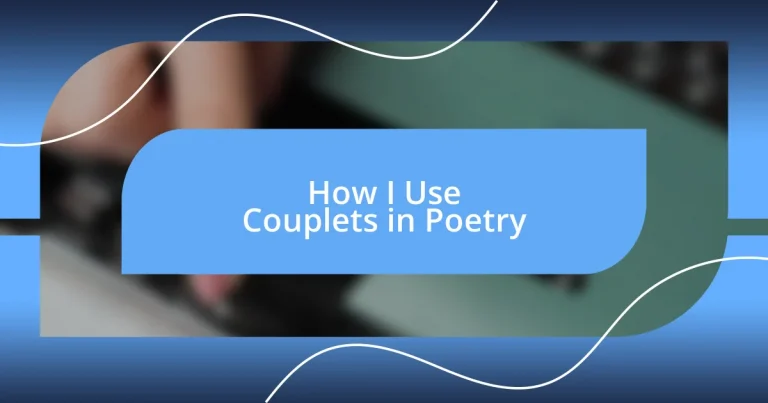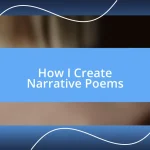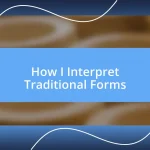Key takeaways:
- Couplets are versatile poetic forms, expressing complex emotions and imagery in just two rhymed lines, enhancing creativity and reader engagement.
- Different types of couplets, such as heroic, closed, open, and alternate, affect the poem’s structure and emotional response, allowing for a variety of stylistic choices.
- Thematic selection, including personal experiences, universal themes, and contrasting ideas, deepens emotional connections and enriches the meaning of couplets.
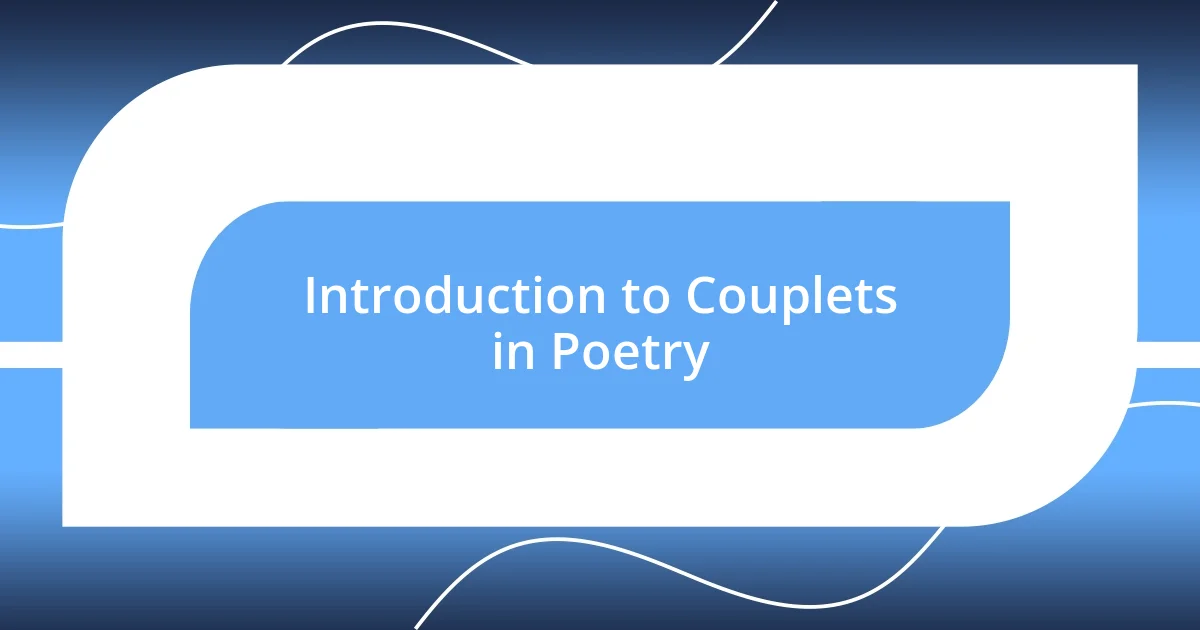
Introduction to Couplets in Poetry
Couplets are a fundamental building block in poetry, consisting of two lines that often rhyme and share the same meter. I remember the first time I experimented with couplets in my own writing; it felt like having a secret code to express emotions in a compact yet powerful way. Isn’t it fascinating how just two lines can convey so much?
When I think of couplets, I’m reminded of their versatility. Whether they appear in love poems or humorous verses, they create a rhythm that pulls the reader in. Have you ever read a poem that made you stop and nod your head, feeling the beat of the words? That’s the magic of couplets at work, crafting sound and meaning together.
In my experience, couplets invite creativity in their simplicity. They encourage poets to be concise yet impactful, compressing complex ideas into manageable bites. Just like a memorable song lyric, a well-crafted couplet can linger in your thoughts—you find yourself reflecting on it long after reading. What moments in your own life would inspire you to write a couplet?
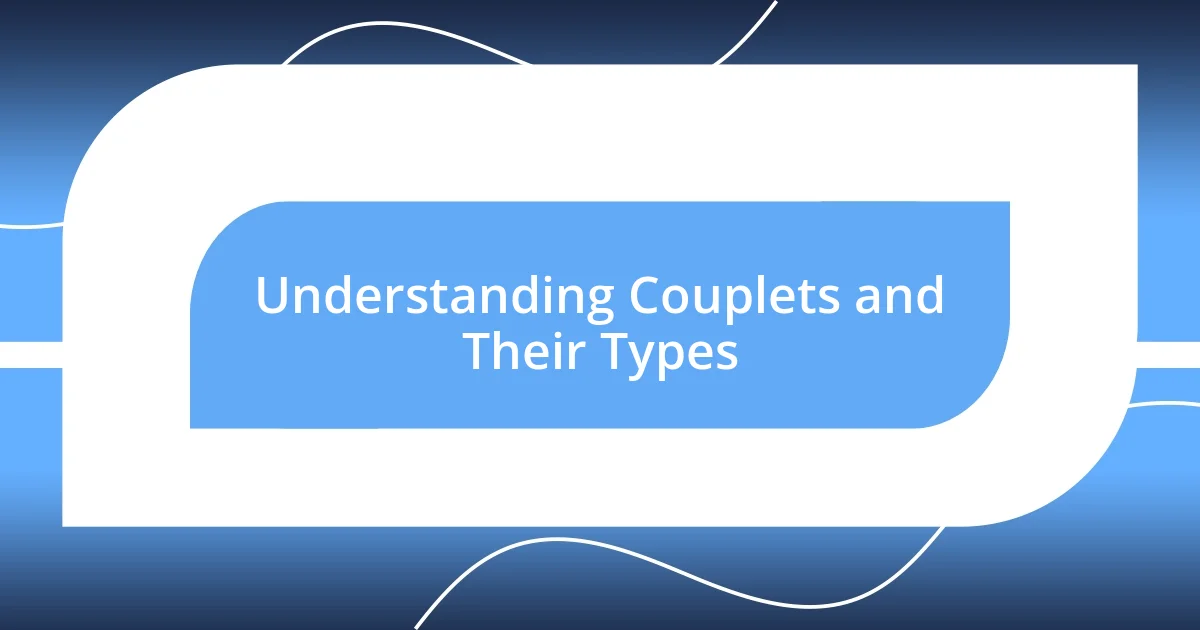
Understanding Couplets and Their Types
Couplets are not just pairs of rhymed lines; they are a unique form that can convey deep feelings and vivid imagery. My first encounter with different types of couplets was enlightening. I began to understand how they can vary in structure and purpose, opening my mind to a world of stylistic choices.
Here’s a brief overview of the main types of couplets:
- Heroic Couplets: These are composed of two rhymed lines in iambic pentameter, often found in epic poetry. They carry a stately, formal sound that elevates the content.
- Closed Couplets: Each couplet expresses a complete thought, giving a sense of closure. I love how they provide a punchy finish that often leaves a lasting impact on the reader.
- Open Couplets: These flow into subsequent lines without a pause, lending to a more narrative style. They create a sense of continuity I find particularly useful for storytelling through poetry.
- Alternate Couplets: Here, the rhyme scheme alternates, producing a dynamic rhythm that can keep readers engaged. This type feels almost playful to me, like a dance of words.
Identifying these types helped me appreciate how each structure can evoke different responses. I remember crafting an open couplet when I was inspired by a sunset; the lines flowed seamlessly, capturing that fleeting moment of beauty in a way that felt truly alive. Have you ever felt that same rush?
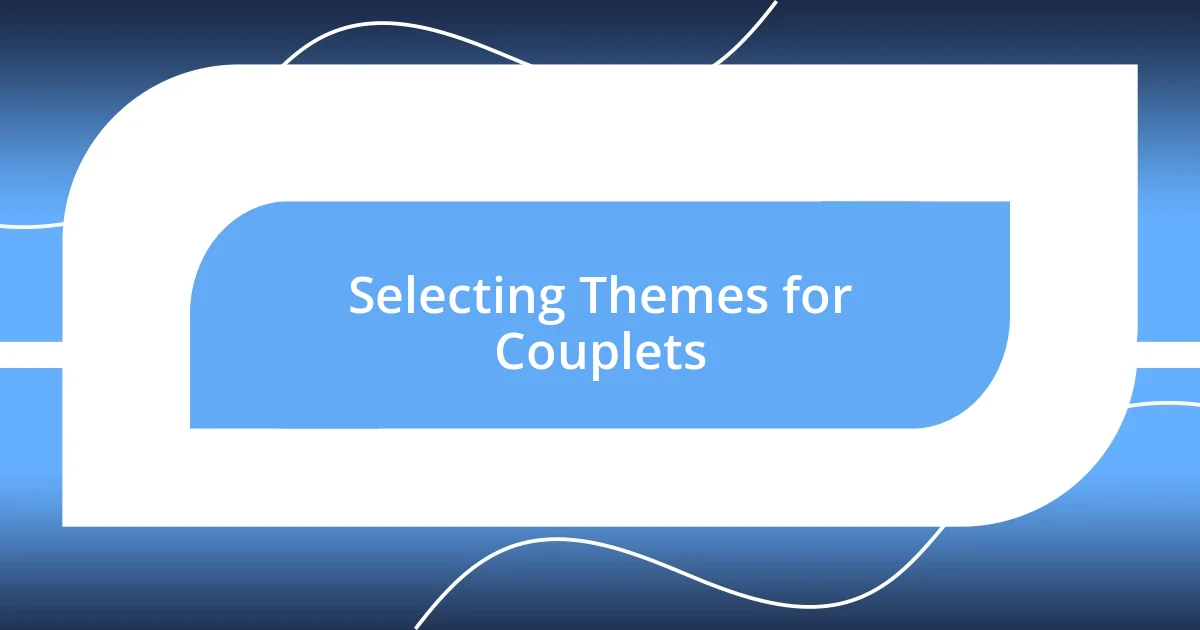
Selecting Themes for Couplets
When selecting themes for couplets, I often draw from personal experiences or significant emotions. I remember vividly the moment I penned my first couplet about nostalgia; it took me back to cherished childhood memories. Choosing themes that resonate on a personal level not only enhances creativity but also deepens the emotional connection with readers. Have you tried capturing a moment from your life in just two lines?
Exploring universal themes like love, nature, or loss can make couplets particularly impactful. For instance, I once wrote a couplet that reflected the bittersweet feeling of a fleeting summer day. Such themes have a way of transcending individual experiences, allowing readers to see their reflections within my words. I believe that when poets lean into these broad themes, it gives their couplets a relatable depth.
Lastly, I find that contrasting themes can create a powerful tension within couplets. Think about joy and sorrow coexisting in a single thought. I once experimented with crafting lines that juxtaposed laughter and tears—each couplet evoking a unique resonance. This complexity can lead to a richer layer of meaning, sparking conversations and eliciting emotions that linger after the reading. Have you thought about how contrasting ideas can enrich your own poetic expressions?
| Theme Type | Example |
|---|---|
| Personal Experience | Nostalgia in childhood memories |
| Universal Themes | Love, nature, or loss |
| Contrasting Themes | Joy and sorrow coexisting |
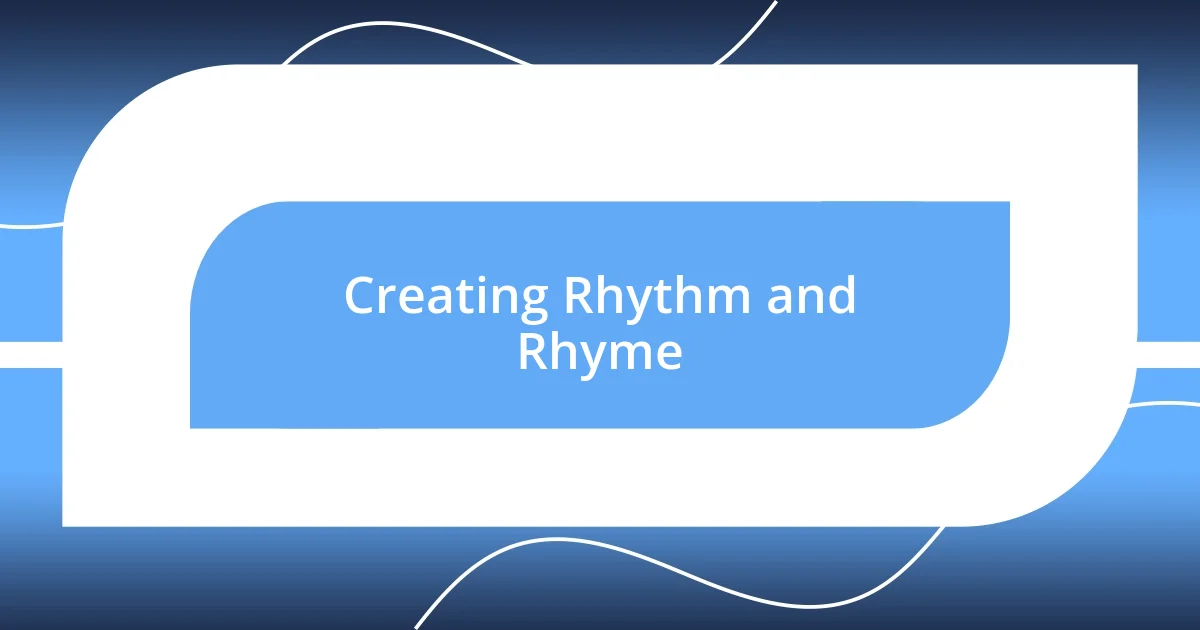
Creating Rhythm and Rhyme
Creating rhythm and rhyme in couplets is like tuning a musical instrument; each line must harmonize with the other. When I write, I often find that the meter plays as much a role as the rhyme itself. For instance, I once penned a couplet about the whispers of the wind, consciously selecting a rhythm that mirrored its gentle flow. Don’t you think the rhythm can also evoke emotions in a subtle yet powerful way?
I’ve discovered that choosing the right rhyme scheme can elevate the couplet’s impact. In one of my earlier works, I opted for an AA rhyme scheme, which created a satisfying sound that left readers wanting more. It’s fascinating to think about how two simple words at the end of each line can evoke lasting imagery. Have you ever noticed how certain rhyming pairs just feel right together, almost as if they were meant to be?
In my experience, the beauty of couplets lies in their ability to create a dance of words. I remember crafting a playful couplet about dancing leaves during autumn. The way the rhymes bounced off each other captured the very essence of their lively descent. It’s a joyful reminder of how rhythm and rhyme breathe life into poetry, don’t you agree?
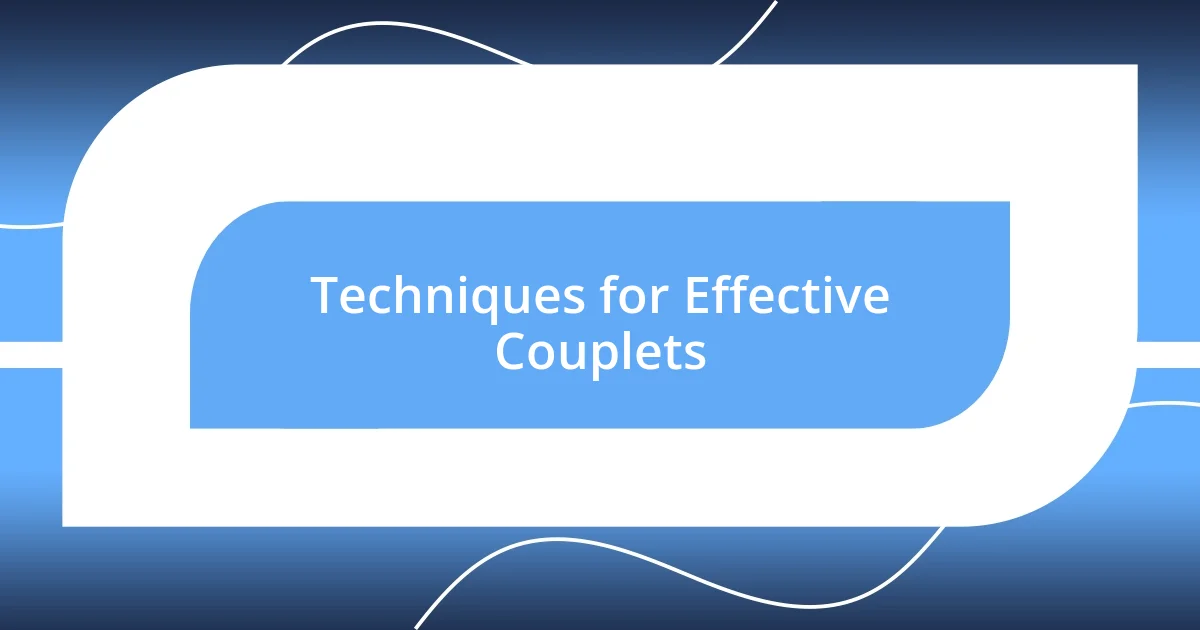
Techniques for Effective Couplets
When working on couplets, I often pay attention to the image I want to create. For example, once I wrote a couplet about a starry night, where each line painted a vivid picture of the twinkling sky. It astonished me to realize how just two lines can evoke such strong visuals; have you ever noticed how imagery can transport you to another place?
I also find that using alliteration can add a lyrical quality to couplets. During a creative burst, I crafted a couplet that highlighted the “soft whispers” of the night. The repetition of sounds not only enhanced the flow but also deepened the emotional undertone. Isn’t it incredible how the sounds of words can shape the emotions behind them?
In my experience, brevity is the soul of a great couplet. I remember writing a quick couplet about fleeting moments; each word was carefully chosen to maximize impact. It taught me the value of precision—sometimes the best lines are those that convey deep emotions in the simplest way. Have you ever felt the weight of a single word in a line, making the entire piece resonate with power?
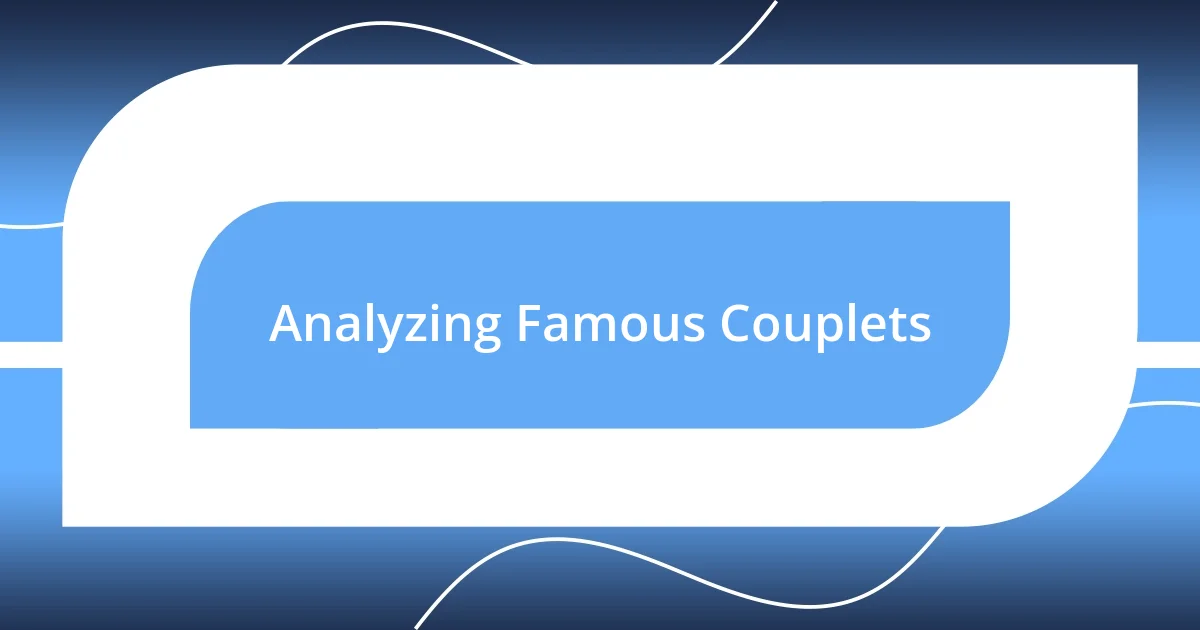
Analyzing Famous Couplets
When I analyze famous couplets, I often marvel at how they encapsulate universal truths. Take the timeless couplets of Alexander Pope, for example; his wit and keen observations pack profound insights into life and human nature. I remember reading lines like “To err is human, to forgive divine,” and I felt a wave of recognition wash over me. Doesn’t it strike you how a few well-chosen words can resonate through time?
Shakespeare’s couplets are another treasure trove of depth and emotion. In “The expense of spirit in a waste of shame,” I felt the poignant interplay between love and regret. It’s amazing how his lines convey not just meaning, but also an entire spectrum of feelings. Have you ever considered how a couplet can reveal the complexity of human experiences in just two lines?
Looking at contemporary couplets, I often see how poets like Maya Angelou use them to capture resilience and empowerment. One of her couplets struck me with its raw strength and rhythm, showcasing how couplets can serve as a powerful vehicle for personal and societal messages. It makes me wonder if we’re just scratching the surface of what couplets can achieve in modern poetry—what do you think?
